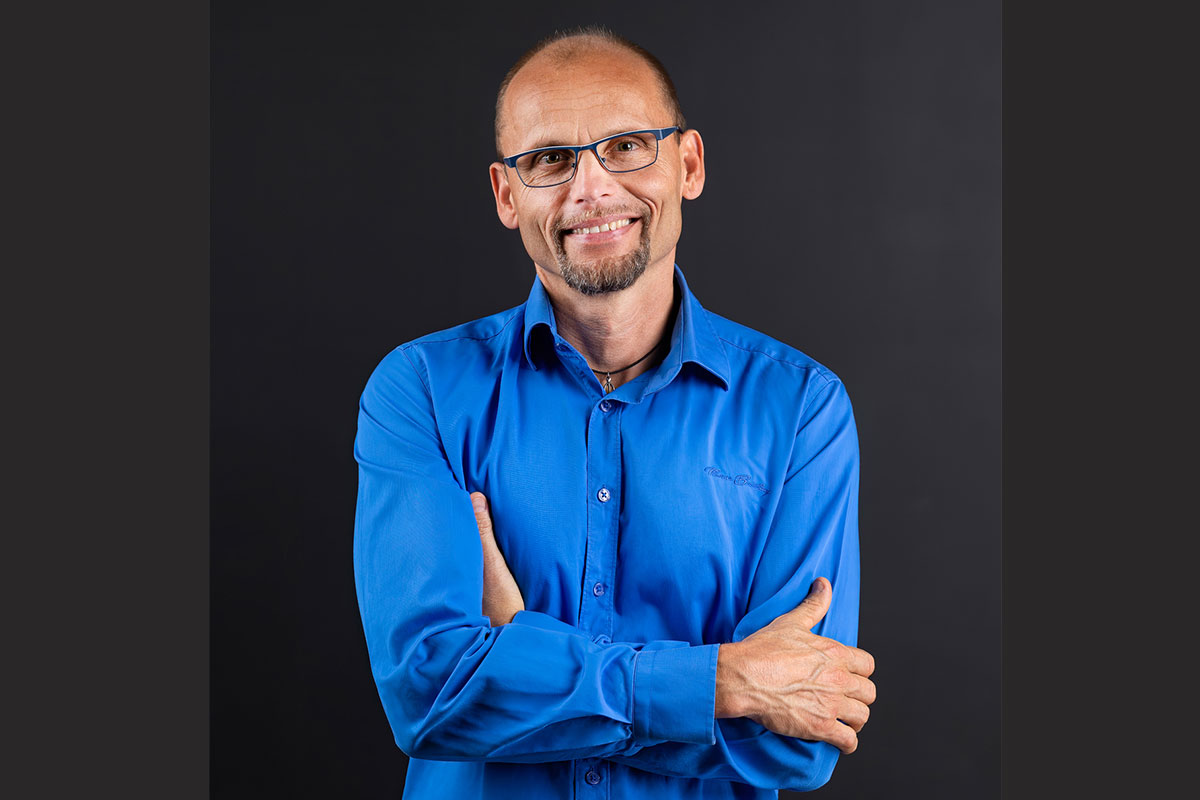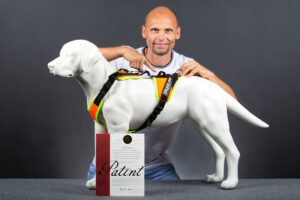
28 Oct Intelligent dog accessories harness next-level innovations
Julius Sebő, CEO and founder, Julius-K9, discloses how the multi-award-winning manufacturer stays ahead of the times to create perfect products for pets and their owners
Julius-K9 is fascinating made-in-Hungary success story. The company started back in 1997 and, from a small business operating in a 15-square-meter garage, it became one of Europe’s leading dog accessory manufacturing brands. To start this interview, how would you summarize your corporate story? What was your vision when you founded the company and what have been the key drivers that led you to such success?
Julius-K9 started out as a family business of just two people. We had modest expectations when we entered the market. I used to work in Austria as a dog trainer and I was fully committed to working with dogs, especially with service dogs. Back then, I had the impression that there wasn’t any really good equipment for service dogs to boost their performance or help them in their work. So for three years, I did nothing but study the market and poll Austrian police chiefs on their expectations regarding equipment and accessories: what they needed, what kind of help they could use and so on.
At that point, we started manufacturing service-dog equipment as well as human military protective equipment. Thanks to our initial success, we were able to participate in the Dortmund World Dog Show in 2003, where we had an amazing response to our products. We got an insight into the market and the window of opportunity it offered. That’s when I truly understood the essence of innovation: you need to be ahead of your time in such a way that people are fascinated by what you offer, and they can’t get enough of it because it affects their intellect and touches their heart too. We realized that there might be a demand for our dog equipment products all over Europe so we could actually make a living from this business. We streamlined our portfolio: we stopped making military protective equipment and focused all our efforts on dog equipment. Yet we never forgot our roots and the kind of quality expectations we had to meet when we were producing military equipment. We carried on with this approach and integrated the high-quality standards into our own dog equipment manufacturing processes.
Could you give us some key facts and figures so that our readers can better understand Julius-K9’s significance and development over the years?
The year 2009 was a major milestone for our company: we sold 10 million units. This achievement put us on the map. That year was also a turning point because we started to patent our products from then on. Before that, we had been entangled in long and intense legal battles as our products and equipment had not been patented and our intellectual property rights had constantly been violated. So in 2009, we started to protect our brands from the counterfeit products dumped on the market around those years. These copycats squeezed us out of the biggest retail chains.
We had two key strategies to overcome this difficult situation. Firstly, diving deeper into innovation, we created a new product line. And secondly, we started to enforce our legal rights. After winning some major legal battles, we managed to squeeze out the copycat products and regained our place on the supermarket shelves. This period was characterized by constant growth in terms of output and turnover. We also decided to never again release a product without having it fully patented and enjoying the full protection of the law. This was the only way for us to get out of this situation, maintain our position in the market and keep our manufacturing in Europe.
We want full legal protection for our products in all key markets because these copycats not only squeeze us out, but they also challenge the identity of our business, which is characterized by innovation. We are inventors and we insist on keeping it that way. Thanks to this approach, our mother company has been able to demonstrate a constant annual growth of around 5-10 percent, while some of our resellers actually grow by 50-60 percent a year. The novelty of our products seems to have such an impact on the market that we can’t fully satisfy the demand. 98 percent of our products are manufactured in Hungary where we employ 500 people. Our total annual sales from Hungary have reached €20 million.


Although you originally studied architecture and music, you eventually dedicated your life to pet innovation. Can you tell us a little bit more about Julius-K9’s flagship products: how do they stand out when compared to their peers and what kind of added value does Julius-K9 bring to its customers?
Our first innovation that really had an impact and helped us to make a breakthrough was our so-called speaking harnesses. These products had a major effect on dog owners and non-dog lovers alike, because they caught the attention of people not involved with dogs too. We call them speaking harnesses because they have replaceable patches with different inscriptions that you can change according to the message you want to communicate through your dog’s harness. Our customers deeply cherish every minute they can spend with their dogs.
This idea of replaceable labels initially came from police dogs, where human-dog cooperation is exemplary, by the way. Police dog handlers have a ‘POLICE’ label on the harness of their dog but when they return home after work, the label doesn’t apply any more as the dog is no longer on duty. So they need a different label. Thousands of funny labels were created and they had a major impact on our whole society, and not just with dog owners as the eye-catching design of the harness and the interesting labels attracted everybody’s attention. I believe these labels have greatly contributed to the positive image associated with dogs in our society.
What’s currently in your innovation pipeline in terms of new concepts or products?
Throughout the years, we’ve demonstrated our ability to renew ourselves and take our product innovation to the next level in order to surprise consumers. Lately, we’ve been focusing on a more scientific approach in product development. Our latest innovation relies on the findings of physics and medical science—more specifically, anatomy. We are using analog and digital instruments to analyze the correlation of movement patterns when you walk your dog on a leash: we are looking at how the muscles and the joints are affected, and how we could develop a perfect musculoskeletal connection. Our research shows that many micro-vibrations are generated in the bodies of dogs and humans during their walk, especially when they are connected by a leash. There are numerous physical impacts we need to consider. For example, our Longwalk harness is designed to dampen and absorb these micro-vibrations, which has a beneficial effect on humans and dogs alike.
To what extent are you incorporating smart technologies into your products?
We are incorporating all kinds of technologies and this is a huge task. When it comes to their dogs, owners now want the same kind of technological applications that are available for humans. This is a never-ending challenge for developers and we must be up for it. In 2021, Julius-K9 will introduce an intelligent dog harness.
Julius-K9 has expanded to become a global brand and is present in many international markets. What are your priority and most promising markets at present?
Our biggest priority markets are always the ones where dogs are loved and have an increasing role in society. We have various analytical processes to identify those markets, but our number-one target market is the U.S. Europe is important as well, and it actually serves as our laboratory and testing ground, where we test our products before launching them in other markets.
The area where we are lagging behind is not sales but communication and marketing cooperation with local resellers and partners. Working with partners is typically a slower process than going straight to the market and establishing a daughter company.
How are you working to expand your commercial presence, grow your distribution network, and develop new collaborations, alliances and partnerships?
Our partners have been reselling our products with a minimal marketing budget for two decades. As a result, our messages were not communicated sufficiently to the customers. Thanks to the breakthrough in online technologies, we are changing that now. We are limited by Europe’s existing manufacturing capacity too. To make a perfect dog harness, we need to control the entire manufacturing process as well as the production of the raw materials. That’s why we have invested in metallurgical, plastic and textile works. By putting out high-quality products, we can show due respect to our customers and lead the way in environmental consciousness, too.
Do you have any plans to diversify your portfolio?
We want to see some other innovative products being marketed under the Julius-K9 name. We have 220 brands all over the world at the moment. We would be willing to license them to foreign companies, as long as they have the capacity to give proper service to our brand name. For example, this is how Julius-K9 dog food became so successful in the market. In order to ensure legal security for these products, we often have to make agreements with the world’s biggest companies, which allow our licensees to sell the products safely under the Julius-K9 brand name.
As we close the 2020 chapter and prepare for a new business year, what are your plans and ambitions for taking your company to the next level?
I think good goals attract good people. Instead of targeting higher sales, which would require more materials and generate more problems in turn, my plan is to write history again with some new innovations, which will hopefully have a positive impact on our sales as well as help us future-proof our business. Analyzing the company’s recent past and the current situation, I came to the conclusion that even though we’ve had some dynamic years, now we have to prepare for some truly turbulent times. The past few years have demonstrated how risky it is to rely on human resources alone. All market players have been moving toward automated manufacturing processes. In my opinion, the viruses of the distant future will target automated systems instead of people. If the ongoing trend continues, we’ll get to the point where there will be no more professionals left to replace virus-ridden automated mechanisms. My goal is to find the right balance between human resources and automation in all our future planning. It’s the responsibility of an inventor to design products for which they know they will always have the capacity and human resources to manufacture. As an inventor, I feel I need to make sure that my ideas are feasible to the point of mass production. I expect our good brand to attract talented people, which will greatly contribute to practical implementation.
What would be your final message for our Newsweek audience?
We are living in difficult times, and dogs are always good companions in difficult times as they keep us inspired. Dog owners or not, we shouldn’t let the pandemic or the lockdown keep us from being active. It’s time for all of us to look into ourselves and carry out our own innovation: renew ourselves and our environment in the best way we can.

Sorry, the comment form is closed at this time.